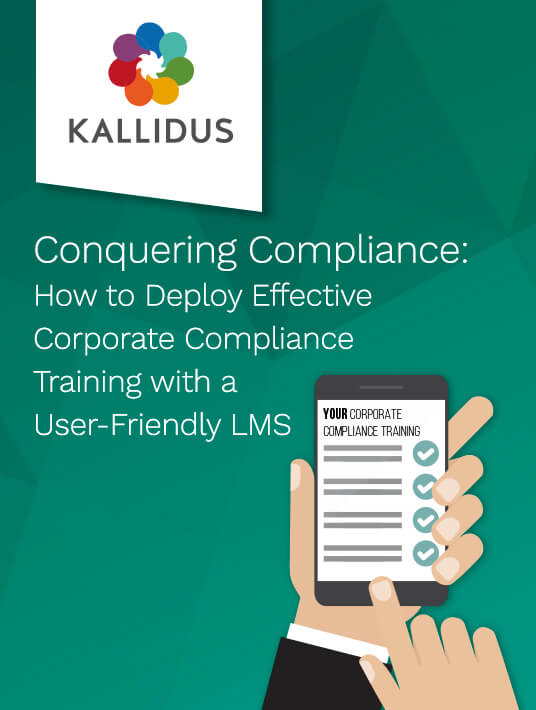5 Ways To Optimise Your Compliance Training Strategy
Compliance training is one of the most fundamental considerations for initial and ongoing learning in any organisation. As such, this need should be met with a strategic compliance training plan. The best way to optimise any form of strategy is to spend time reviewing your current and past practices and marry those up with your present and projected needs.

These are some of the areas you can assess to help you optimise your compliance training strategy in order to not only meet legal requirements but also add genuine value to your organisation from the ground up.
1. Does Your Current/Previous Strategy Line Up With Organisational KPIs?
First things first, you need to review the overall learning and compliance-specific strategy you have had in place over the last financial year. Your corporate learning strategy, just as the compliance training itself, should be goal-oriented. Goal orientation is one of the best ways to enhance the development process, whether in the learning of your workforce or the achievement of organisational KPIs.
Take a look at how specific your compliance learning objectives are, and if they line up with the top-level KPIs of your organisation. For example, if one of your KPIs is to reduce training costs and implementation time, you can start by looking at how to increase completion rates while reducing the hours involved. Provident, in partnership with Kallidus, introduced mobile learning for their compliance training, providing flexible learning conditions for their workforce. This then resulted in a 98% completion rate with reduced hours needed in classroom-based training and manually chasing up from their L&D teams.
2. How Do You Measure Results?
SMART objectives have been around for decades and with good reason. They create a clear structure for your strategy be it on an employee or organisational level. In case you haven’t heard of them before, here’s how they work:
- S - Specific
- M - Measurable
- A - Assignable
- R - Relevant
- T - Time-based
While this isn’t the 'be all and end all' for objective setting, it’s a great structure to start with if you’re looking to optimise your current training strategies. Take a look at how you measure your current top-level KPIs and learning strategy results. Are your results clearly measurable beyond basic completion rates? It’s also worth considering how you report on these results and how regularly you do so.
You could, for example, focus this reporting on the resource required to complete various elements of your compliance training. Look, for example, at if you could streamline your processes and physical staff resource by integrating more technology into your learning strategy.
3. How Does Technology Fit In With Your Current Strategy?
Many organisations use a blended approach to their learning strategy, combining eLearning with more traditional classroom-based approaches. While classroom-based learning definitely still has a place in specific training situations, the use of eLearning and mobile learning in compliance training comes with a wide range of benefits.
Using more technology in your corporate learning strategy can increase efficiency, reduce costs, and boost completion rates across the board. Introducing this level of technology can also aid the incorporation of workplace development into the lives of your workforce, many of whom are likely accustomed to using technology frequently in their day-to-day routines.
Whether your current approach is primarily classroom-based, eLearning based, or blended, it is always worth considering the latest eLearning technological developments. Mobile-ready LMSs, for example, are a great place to start as they will allow you to adapt your training to current and future technological needs.
4. How Adaptable Is Your Strategy To The Changing Needs Of Your Organisation?
Each type of learning enables different levels of flexibility. While compliance training is there to meet specific needs, both the organisation and the laws pertaining to its industry, flexibility is still key to engagement and completion rates. Providing this flexibility to your workforce encourages them to take their development into their own hands, which can then improve workplace learning culture from the ground up.
It is also worth considering how your objectives and strategy can be adjusted on a wider scale. Microlearning, for example, allows flexibility at all levels, not just for the employees completing the training, but also for those implementing the courses. If one specific part of the law or company standards changes, microlearning allows for a more flexible approach to editing your current courses. This also reduces hours needed for in-person training and larger modules on an LMS.
Using a flexible LMS that incorporates mobile learning, and the microlearning that should naturally follow, allows your organisation to adapt at short notice without causing widespread disruption. You can also make use of automated notifications, organisation-wide roll-out of specific courses, and renewals of any training that needs updating or refreshing.
5. How Can You Exceed Minimal Compliance Requirements?
Optimising your compliance training strategy doesn’t just have to come in the form of improving efficiency and completion rates. Undergoing this process is the perfect opportunity to evaluate what it is you really want from your compliance training. For some organisations, particularly SMEs, minimum requirements fit with current budgets and time constraints. However, for larger organisations, the focus of compliance training can be much broader than following the law.
The benefits of exceeding minimum compliance standards are tangible and can be significant on a larger scale. Let’s talk about physical wastage in retail as an example. Using compliance training to actively reduce wastage can not only increase profits but also reduce the business’ impact on the environment. This sort of initiative can also be used to generate positive press around the organisation’s environmental aims which can, in turn, improve the relationship between business and organisation.
So whether you’re focusing on technology, efficiencies, or how you can push your compliance training further, optimising your compliance training strategy comes in many forms. Boiling down to the basics, take a look at what you’re doing now and what you’ve down over the last year. Assess and identify any gaps in your current results, and take a step back to consider if you’re measuring success in the most beneficial way. Once those are identified, have a look back through our questions to figure out how best to optimise your compliance training strategy to achieve optimal results at all levels of your organisation.









